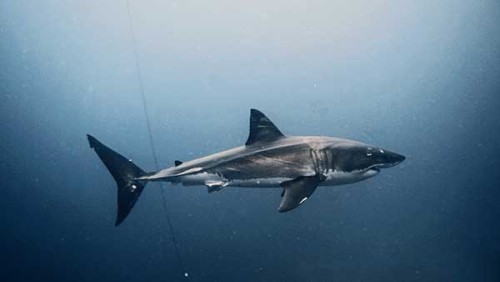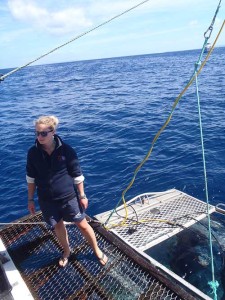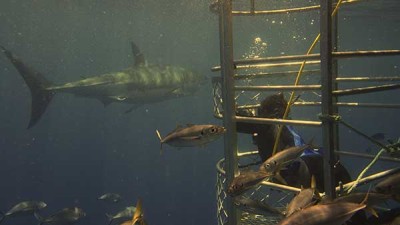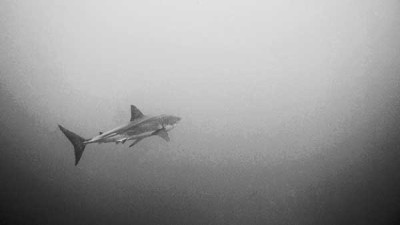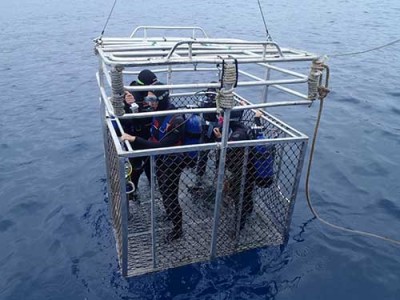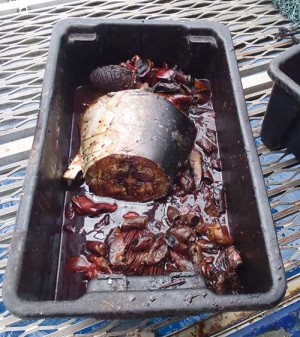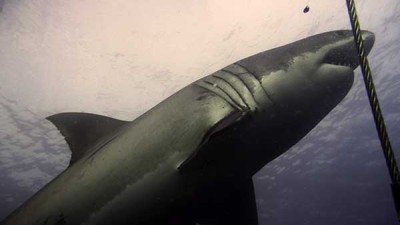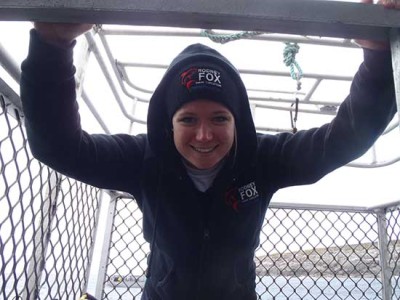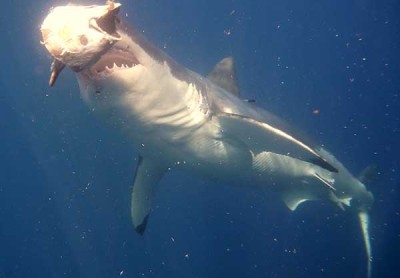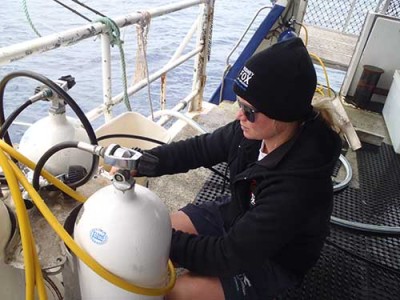I was cable-tying regulators onto the top of the shark cage. It was buoying up and down in the swell. I was trying my best to keep my balance so as not to fall into the shark infested waters. I was pretty comfortable though, knowing that it takes a while for the sharks to show up. Then came the shout from the top deck: “SHARK!” Cue a great white shark breaking through the water barely a few feet from the cage. Well I can tell you that I pranced off that cage pronto. I like to think I resembled a little gazelle nimbly fleeing from a cheetah, but lets be realistic.
There was one cable-tie still to go…
Despite enduring some of the most terrifying experiences of my life, crewing on the Rodney Fox Shark Expeditions boat for three trips at the beginning of the year proved to be the ultimate start to 2012. Great white sharks are one of the most feared creatures in the ocean and indeed the entire animal kingdom, so some of us take it upon ourselves to dive with them. Crazy some may say – pretty freaking cool I say.
Diving with great white sharks has become something of a bucket list essential for many people and great white shark dive operators have emerged in haste over the past few decades. Rodney Fox Shark Expeditions is not only the original great white shark diving experience; it is also one of the most conscious operators in the world when it comes to maintaining respect for the sharks. Based in Port Lincoln, South Australia, this company places great emphasis on increasing divers’ overall awareness of the sharks. The focus is on observing a wild animal and understanding its rightful place in the oceans. Still, you will …. yourself when you see one for the first time.
In order for divers to gain this appreciation and understanding for the great whites the Rodney Fox trips are not a jump in jump out affair. You spend time at sea and learn about the sharks, you dive with them throughout the day and compare notes in the evening. What’s more, these dives are not all about dropping into a cage bobbing around on the surface. There is also a bottom cage…
One of duties during my time on board was that of “Cage Captain”. This little metal cage holds four divers, and plenty of tuna guts. The cage dangles off the side of the boat and is lowered toward the ocean floor by a hydraulic crane. I couldn’t help but note the remarkable resemblance of this situation to bait on the end of a fishing line… It was my job to ensure the other divers were safe and happy (or as happy as can be considering the circumstances) and to communicate to the surface via my comms line by pulling on the line with a series of pre-defined tugs. I also had to make sure the tuna gut juice was still circulating in the water by stomping on the guts. Joy.
During my second Cage Captain duty I watched in astonishment (and fear) as a great white shark took it upon itself to tear through my comms line. Its head swung from side to side with aggressive strokes. The cage clattered around as the strength of the shark surged through the line. I looked on and wondered how on earth this scenario was going to play out. Snap, the line was gone. I looked toward the other divers in the cage, putting on my best “ok folks, no worries here, this is easily resolved” face. It’s amazing what can be conveyed through your eyes underwater. Not that I needed to worry – high fives and nods of “yeah that was awesome” were plentiful; my divers had evidently enjoyed the spectacle. And indeed it was awesome – sometimes the scariest things in life just are. Plus, we were never really in danger considering the amount of safety procedures onboard. It must have been pretty obvious what had happened when Pete the skipper pulled on the comms line and found that it just kept coming!
Having the bottom cage is unique to the Rodney Fox Shark Expeditions. It is a great way to observe the sharks and it is remarkably different to the surface cage experience. I found the bottom cage to be an incredible way to view the sharks. As I watched the great whites cruise through the water there was ease to their movements unbefitting to their burly form. They may be the ocean’s most feared predator but their colour, movements and behaviour are beautifully refined. Their eyes are black but they are certainly not lifeless. The sharks would pass close by the cage and I could see the flicker in their eyes as they gave the cage contents a thorough once over. Hundreds of millions of years of evolution has produced this immense ocean hunter and as I stood in the cage I could see that the sharks are incredibly stealth creatures, not crazed killing machines.
The surface cage is more high impact – the sharks are feistier as they are attempting to outwit the bait handler. By law feeding the sharks is illegal, so these bait lines are purely used as lures. Still, the sharks continuously make noble and calculated attempts at stealing the bait. With this comes breaches, gaping jaws, tail slaps and cage knocks, which is enough to stun even the tough guys in the cage. It takes a talented bait handler to ensure the tuna chunk on the end of the line remains intact – you need to be able to read the sharks and understand their behaviour. You need to interpret their movements and anticipate what will happen next.
My attempts at bait handling were pretty pitiable in comparison to the more experienced guys. During my first trip I observed Rodney Fox’s son Andrew, along with the deck hand and my fellow cage captain Toby (aka “Tuna Boy” and self proclaimed “Number 1 bait handler in the southern hemisphere”), manning the bait line with ease. They repeatedly pulled in the line at just the right moment – an intact tuna chunk emerging time after time. In the meantime the divers in the surface cage would be witnessing a sudden high-speed shark bolting past with its abysmal jaws primed for a nibble. A stunning sight.
Although my bait handling skills were not quite a match for those of Tuna Boy, I did learn a huge amount during my time on board the boat and I did manage to pull up a few intact tuna chunks. Andrew Fox and Jennifer Taylor, who together organize and run the expeditions, gave me an opportunity beyond compare by letting me join the expeditions as a crew-member. I am extremely grateful that they allowed me to get so involved with the onboard duties. It was a chance for me to learn new skills and develop my competences. It was hard work and I reeked of tuna gore by the end of every day, but this was an extraordinary experience and one I would repeat in an instant. They say what doesn’t kill you makes you stronger. Too true.
